文章信息
- 王玥, 周旺明, 王绍先, 牛丽君, 代力民
- WANG Yue, ZHOU Wangming, WANG Shaoxian, NIU Lijun, DAI Limin
- CLUE-S模型在长白山自然保护区外围规划中的应用
- Application of land use model CLUE-S in the planning of surrounding the Changbai Mountain Biosphere Reserve
- 生态学报, 2014, 34(19): 5635-5641
- Acta Ecologica Sinica, 2014, 34(19): 5635-5641
- http://dx.doi.org/10.5846/stxb201301140090
-
文章历史
- 收稿日期:2013-1-14
- 网络出版日期:2014-3-7
2. 沈阳建筑大学管理学院, 沈阳 110168;
3. 长白山科学研究院, 吉林省长白山保护开发区, 吉林 133613
2. Management School of Shenyang Jianzhu University, Shenyang 110168, China;
3. Changbai Mountain Academy of Sciences, Changbai Mountain Protection and Development Zone of Jilin Province, Jiling 133613, China
近年来,森林生态系统类型自然保护区大力发展生态旅游项目。但由于基础设施和旅游配套设施的建设受《自然保护区条例》的限制,只能建在保护区外围,需要占用保护区边缘及邻近外围乡镇大量土地,这势必会加快这些区域的土地利用变化以及对区域资源环境的影响[1, 2, 3, 4]。针对自然保护区边缘地带研究,国外关注于边缘地带的人口变化研究[5];国内,仅有薛其福分析研究了九寨沟自然保护区周边土地利用/土地覆被变化[6]。长白山自然保护区作为东北地区重要的旅游景点,近些年来游客增长迅速,导致自然保护区周边土地利用变化加剧。但已有长白山地区土地利用和景观格局研究多以自然保护区内作为研究对象[7, 8, 9, 10, 11, 12],而保护区外围土地利用变化研究仅有从林业局尺度分析人口增长和修建旅游设施对区域森林资源产生的影响[13]。因此,针对长白山自然保护区外围土地利用变化的研究以及制定合理的区域土地利用规划具有十分重要意义。
模型方法是土地利用格局变化预案模拟研究的有效科学工具,较为精确的模拟结果可以用于区域土地利用规划。CLUE-S 模型是土地利用变化研究中广泛使用的模型[14, 15, 16, 17, 18, 19],基于土地利用与驱动因子之间的定量关系,对区域内各种土地利用类型之间的竞争进行系统动力学仿真,在模拟土地利用时空动态方面具有明显的优势,能较好地模拟小尺度范围内土地利用变化情景,具有更高的可信度和更强的解释能力[20, 21]。本文应用 Logistic 回归分析了自然保护区外围土地利用变化的驱动力,将 CLUE-S 模型模拟结果应用于区域土地利用规划中,为科学规划提供定量数据分析和技术手段。
1 研究地区与研究方法 1.1 研究区概况长白山自然保护区(41°41′49”—42°25′18”N,127°42′55”—128°16′48”E)地处吉林省的东南部,总面积为196465 hm2,是自然环境和生态系统保存最为完整的森林生态系统保护区之一,在吉林省旅游中占有重要地位。20世纪80年代,最初旅游人数仅为近3万人,到本世纪初增长到20万人,2010年,国内外游客已到244万人次,10年间旅游人数翻了10倍,2010年实现旅游收入20.3亿元,是2006年旅游收入的4倍。
本研究区域为长白山自然保护区外围30 km(图 1)。研究区域内有10个乡镇,5个森工企业,分别为二道白河镇、露水河镇、两江镇、松江河镇、松江镇、泉阳镇、漫江镇、东岗镇、十四道沟镇、长白镇及白河林业局、露水河林业局、泉阳林业局、松江河林业局、长白森林经营局。十四道沟镇和长白镇位于长白山自然保护区以南,距保护区界直线距离近30 km,地形复杂,与保护区交通通达性较差,受保护区旅游影响较小,故本研究中不予考虑。
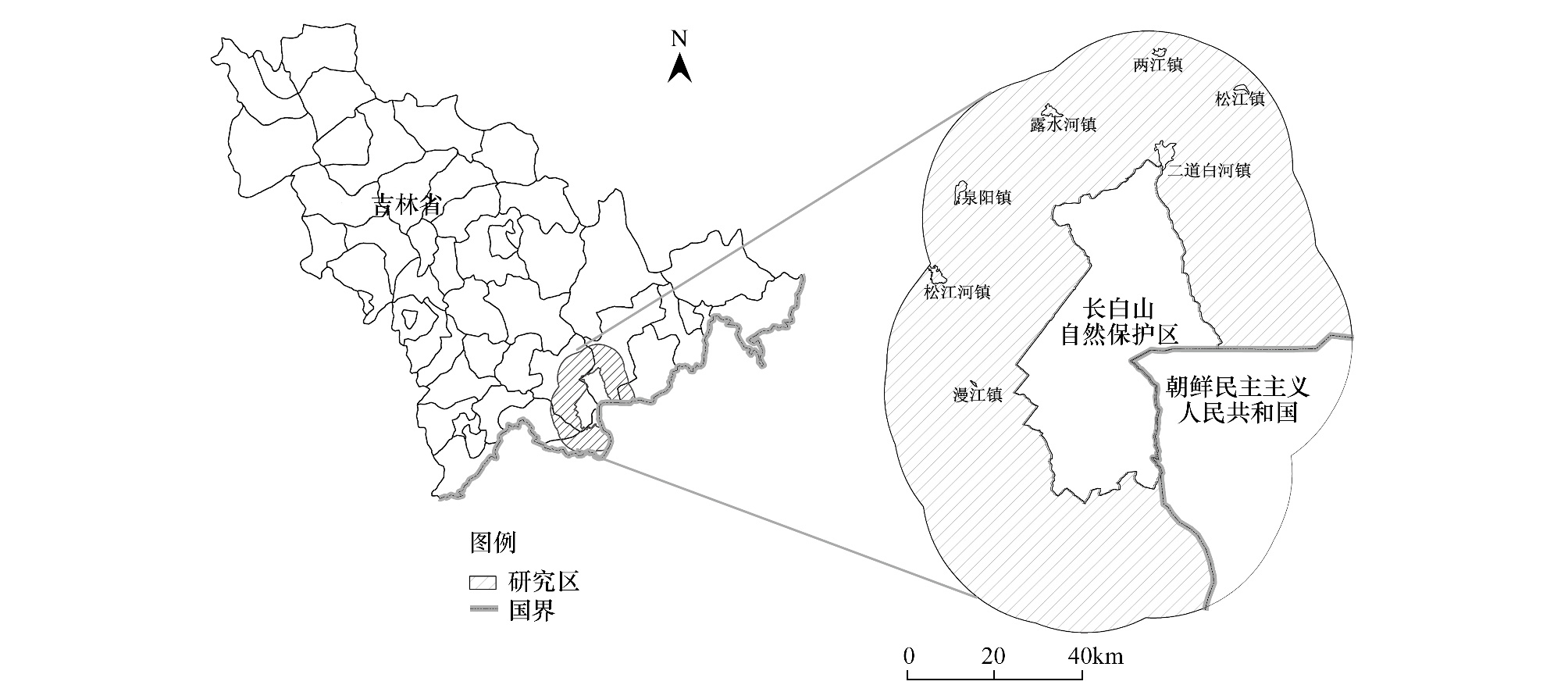
|
| 图 1 研究区位置图 Fig. 1 Location of study area |
数据源选用Landsat TM 遥感影像,包括1991年5月和2007 年10月。应用遥感分析软件ERDAS 9.2,以研究区林相图作为参照,采用监督分类方法,分别对1991年和2007年两期影像进行解译,得到相应的土地利用图(图 2)。应用实地采样点余下的260个采样数据对两期的解译结果进行精度评价,精度分别为90.2%和93.4%。
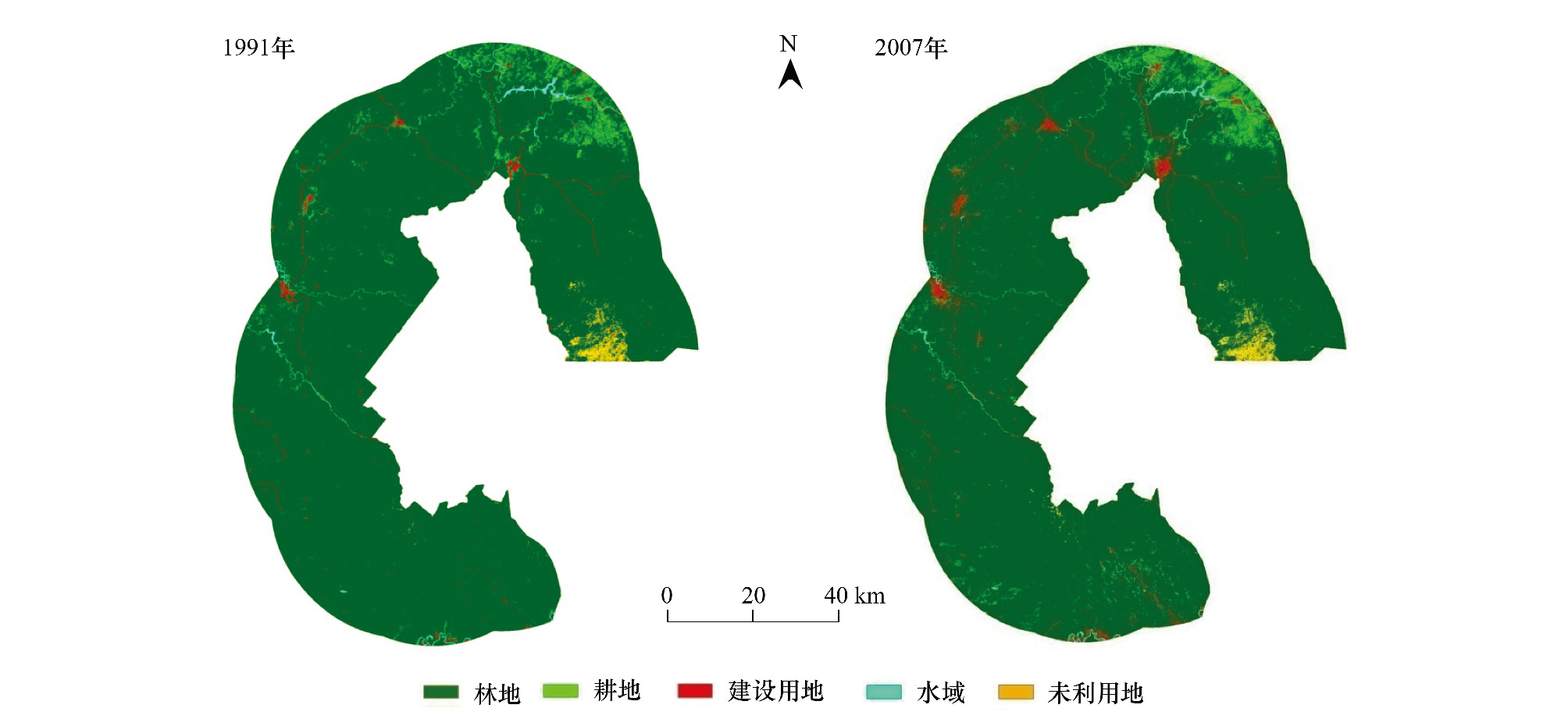
|
| 图 2 1991 和2007 研究区土地利用图 Fig. 2 Land use map of study area in 1991 and 2007 |
根据研究目的,将研究区土地利用分为五种类型:林地、耕地、建设用地、水域和未利用地。设定水域掩膜,以避免人为误差[22]。分类体系中,林地界定为郁闭度大于10%的有林地、迹地以及苗圃;建设用地包含居住、工业、商业、交通等用地;未利用地含荒草地、裸岩以及郁闭度小于10%林地。
1.3 CLUE-S模型CLUE-S模型是荷兰瓦赫宁根大学“土地利用变化和影响”研究小组在CLUE模型的基础上开发的。该模型分为两个不同模块,非空间需求模块和空间分配模块。非空间需求模块土地利用变化的计算基于统计层次,而空间分配模块基于栅格系统将土地需求转化为土地利用变化分配到研究区域的不同空间位置[23]。
1.4 模型数据和参数设置 1.4.1 预案设定基于结果可对比的研究目的,设定城镇总体规划预案。依据长白山总体规划和区域乡镇规划,按照600×600栅格倍数确定到2020年各土地利用类别的面积,然后根据线性插值方法确定2007—2020各年份土地利用变化,以此作为模型中土地需求参数。
1.4.2 空间和时间尺度的确定根据熵理论,相同研究区内的高空间分辨率比低空间分辨率包含更多的熵,能够体现更多的细节信息,但同时也将导致预测不确定性的增加,从而使结果准确率较低[16]。基于CLUE-S 模型中示例的默认参数,从1000 m分辨率(栅格大小为1000 m×1000 m) 开始,以100 m为步长提高空间分辨率。结果表明,在研究区CLUE-S模型最高可运行的分辨率为600 m。因此,本研究选择的空间尺度为600 m。
我国新一轮土地利用总体规划和城市总体规划期末年均为2020年,为了增强结果的应用性和可对比性,将模型模拟目标年设定为2020年。
1.4.3 空间驱动力依据资料可获取性、因子变异性、因子可量化性,同时考虑研究区地处自然保护区外围,绝大部分土地利用类型为有林地,主要选取地形因子、邻域因子、交通可达性因子和人口因子(表 1)。对二元Logistic 回归方程的解释能力一般用Pontius R.G.提出ROC (Relative Operating Characteristics) 方法进行检验。检验指标ROC 值介于0.5 和1 之间,一般认为当ROC值大于或等于0. 70 时方程的拟合优度较高,反之则相对较低。
| 驱动因子 Driver factors | 建设用地 Developed land | 耕地 Cultivated land | 林地 Forest | 未利用地 Open land |
| 到公路的距离Distance to road | 0.00001 | 0.0001 | -0.00005 | -0.0004 |
| 到城镇的距离Distance to city | 0.00001 | -0.0001 | 0.00004 | 0.0003 |
| 到保护区的距离distance to reserve | -0.00001 | 0.00008 | -0.00002 | -0.0005 |
| 到河流的距离Distance to stream | -0.00002 | -0.00003 | -0.00003 | 0.0002 |
| 到铁路的距离Distance to railway | 0.000005 | -0.000002 | -0.000007 | 0.0001 |
| 海拔Elevation/m | -0.005 | -0.005 | 0.005 | -0.005 |
| 坡度Slope | -0.049 | -0.011 | 0.013 | 0.01 |
| 人口密度Population density/(人/hm2) | 0.053 | 0.003 | -0.054 | -0.74 |
| 常数Constant | 0.293 | -0.464 | -0.823 | -10.613 |
| 受试者工作特征曲线ROC(Relative Operating Characteristics) | 0.801 | 0.855 | 0.749 | 0.981 |
模型的验证以1991年作为初期,模拟2007土地利用类型图,将模拟结果与2007年实际土地利用类型模拟对比,验证模型精度。比较模拟的2007年土地利用图与解译得到的2007年土地利用图,其Kappa指数为0.949,表明模型对自然保护区外围土地利用演变模拟精度较高。
2 结果 2.1 模拟结果模拟结果是在驱动因子的综合作用下,反映各种土地利用类型之间相互竞争及其在空间分配上的演替规律。在城市规划预案下以2007年为基准年,模拟2007—2020年土地利用分布(图 3)。各种用地类型随时间的推移大多在原有位置附近发生了一定程度的扩张与收缩。为了满足2020年土地利用需求,保护区以西外部原有零散耕地转变为建设用地,共分配7632 hm2耕地调减为建设用地。研究区南部部分林地转变为建设用地,总计8856 hm2林地转变为建设用地,使得区域建设用地沿原有建设用地向四周扩散,但从总体上看,未大规模连片集中。
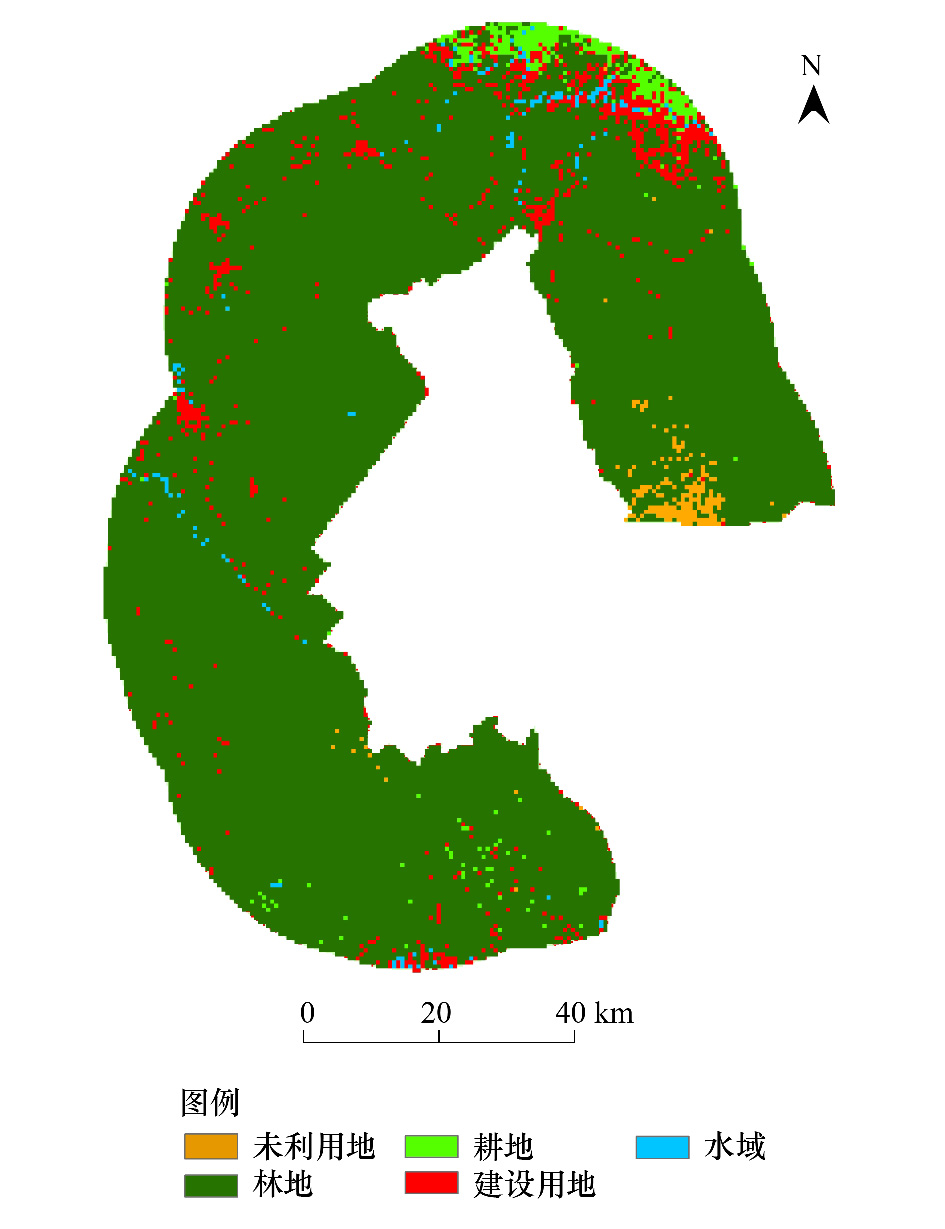
|
| 图 3 2020年土地利用模拟图 Fig. 3 The simulation map of land use in 2020 |
将研究区内珍惜资源保护地、水源保护地、保护区外旅游景区划入限建区。依据CLUE-S模型的模拟结果,在建设用地密集分布区内,根据旅游活动的主题功能和乡镇分布划定适建区(图 4);旅游活动主题功能区是长白山旅游活动的可建区域。

|
| 图 4 研究区空间管制分区图 Fig. 4 Land control zoning in study area |
根据模拟结果确定2020年乡镇布局区域和发展方向(图 5)。研究区7个乡镇以原有建设用地为中心向不同方向扩张,泉阳镇和露水河镇扩展空间较小。松江镇从道路、交通、地形等自然条件看,有很大的转换空间,其外围土地均可为了适应需求而转换利用方式。模拟结果在二道白河镇和松江镇之间给出了大面积的建设用地布局,为了满足研究区2020年建设用地需求,该区域既可以作为建设新区的选址地,也可以作为松江镇发展扩张区域。
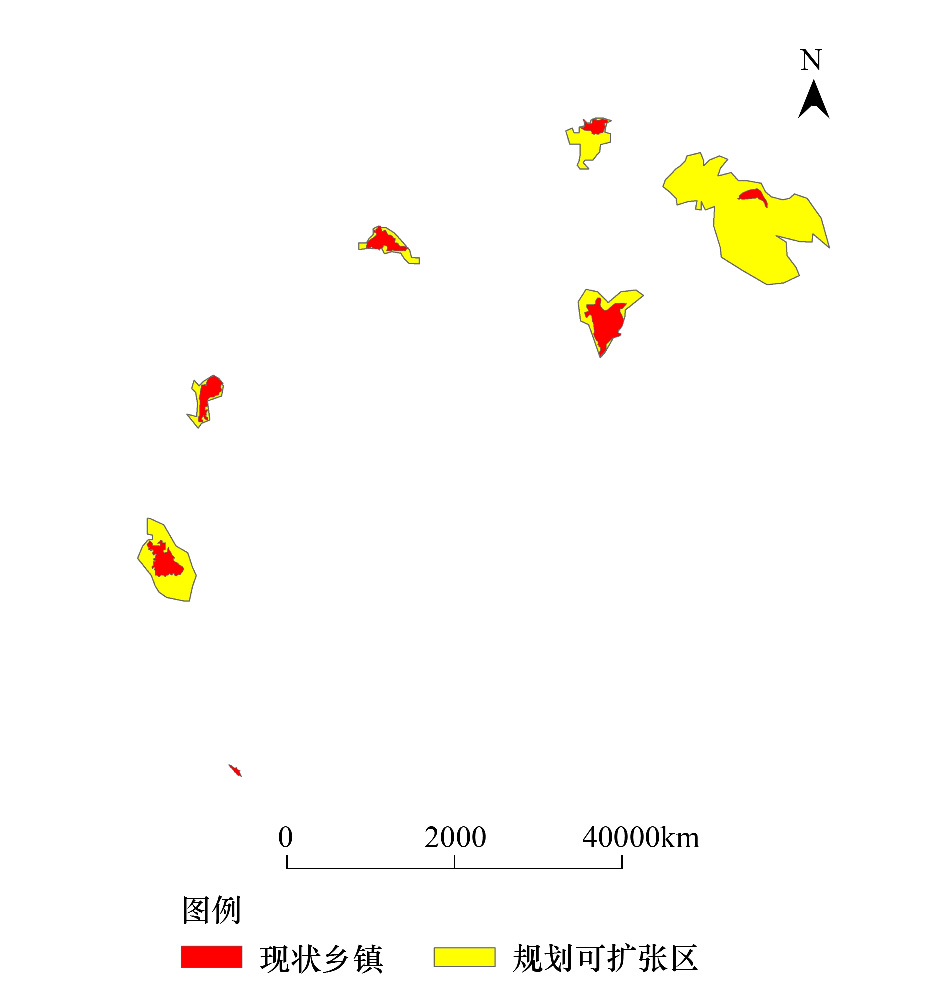
|
| 图 5 乡镇布局规划图 Fig. 5 Townships pattern plan |
根据景观格局指数的意义和敏感性,选取斑块数量、景观形状指数、多样性指数和聚集度指数4个指数在景观水平上从数量、形状和分布3个方面评价格局变化[16]。
1991—2007年,研究区景观的斑块数量、景观形状指数增加,表明整个景观破碎化程度增加,景观异质性更加明显。景观多样性指数由0.2641增加到0.3276,聚集度指数由0.9253下降到0.9090,表明各类景观组分面积比例差别在逐渐缩小,景观中林地组分优势程度减弱,人类活动对于生态环境的影响随着时间推移不断加剧(表 2)。
| 年份 Year | 斑块数量 Number of Patches | 景观形状指数 Landscape Shape Index | 聚集度指数/% Aggregation Index | 多样性指数 Shannon′s Diversity Index |
| 1991 | 467 | 7.0461 | 92.5265 | 0.2641 |
| 2007 | 562 | 8.2321 | 90.9094 | 0.3276 |
| 2020 | 522 | 8.2799 | 90.8757 | 0.3675 |
| 1991—2007变化 Change of 1991—2007 | 95 | 1.186 | -1.6171 | 0.0635 |
| 2007—2020变化 Change of 2007—2020 | -40 | 0.0478 | -0.0337 | 0.0409 |
对比两个阶段景观特征指数(1991—2007,2007—2020),2007—2020阶段斑块数量减少了40,景观形状指数增加0.0478,均小于1991—2007变化量,表明土地利用规划明显抑制区域景观破碎化进程,有方向性的土地利用和规划会减弱人为活动对景观的影响。
3.2 模拟结果与规划图比较研究区已制定的规划为《长白山总体规划(2006—2020)》,《抚松新城总体规划(2010—2030)》。将上述规划整合,长白山保护区外围(含研究区)将形成如下规划布局(图 6)。
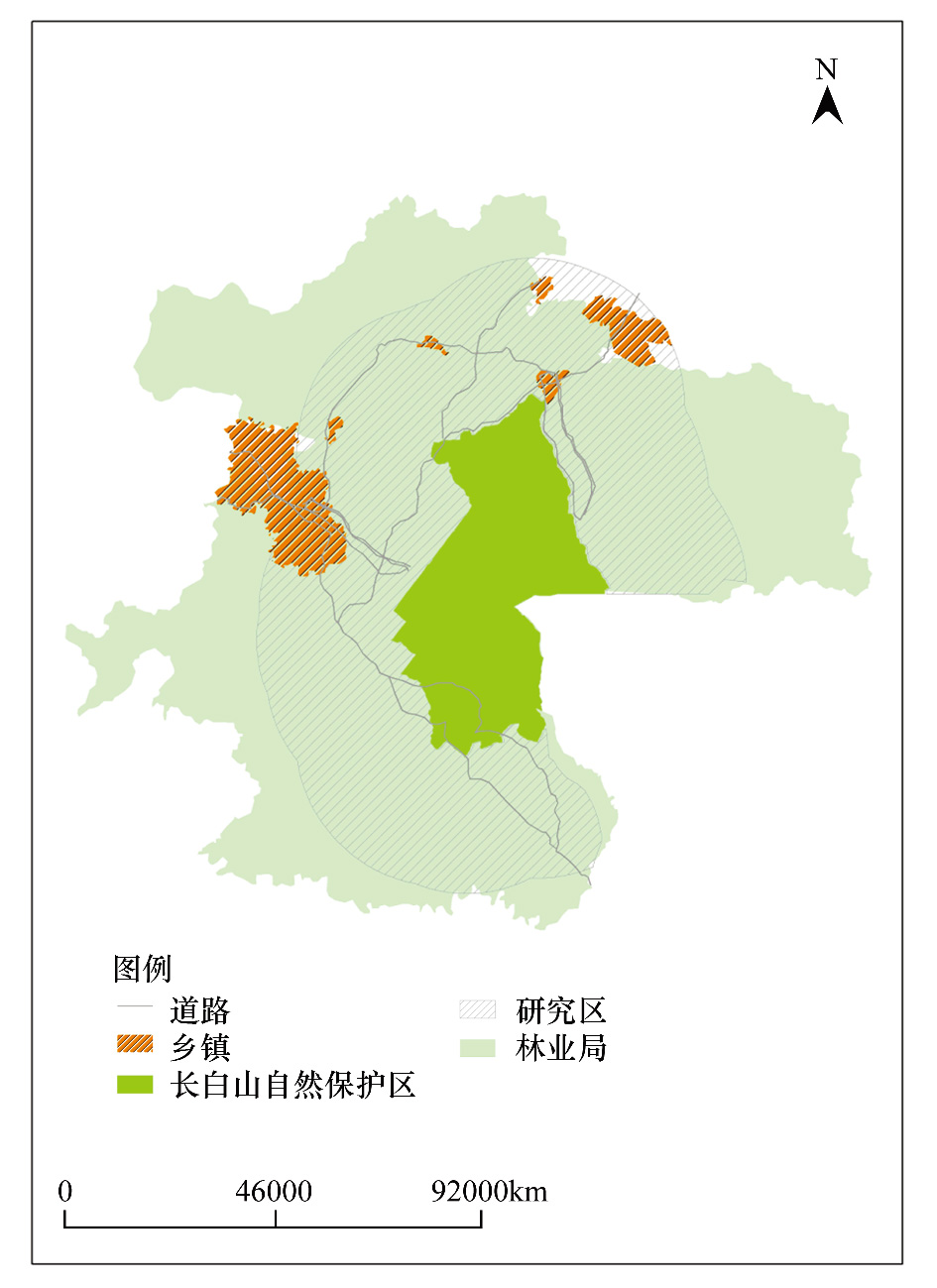
|
| 图 6 长白山保护区外围规划整合图 Fig. 6 Master Plans surrounding Changbai Mountain Biosphere Reserve integrated |
模拟结果(图 3)在保护区以北二道白河镇和松江镇之间给出了大面积的建设用地布局。规划图(图 6)在保护区以西建设生态新城,面积约是模拟结果的两倍。造成这一差异的主要原因是规划图由县级以上政府制订,长白山自然保护区外围行政机构(抚松县、长白山管委会、安图县)均注重区域旅游发展对经济的拉动作用,在各自行政管辖区域内建设生态旅游新城。而模拟结果将保护区外围视为统一整体,按照建设用地需求量选择空间上最大概率转换区域,因此模拟结果新城数量和建设用地面积均小于规划图。
保护区外围存在多个行政主体,为了分享旅游发展的经济收益,均在保护区不同方向提出了侧重旅游的总体规划。规划图(图 6)在长白山保护区西部和北部将建设两大生态新城,与周围乡镇形成网络群,这势必对区域生态环境保护带来严重压力。
4 结论CLUE-S模型是土地利用规划的前期分析和用地配置的有力工具。在土地利用规划过程中,引入景观评价方法是行之有效的,有助于改善传统规划中单纯土地适宜性评价提供的信息不足和对规划评价的定量指标不足的弱点,在促进规划和评价的定量化过程中有重要的实践意义。
长白山自然保护区外围行政机构在各自城市规划中不同程度的提出发展旅游配套产业和设施,以此增强区域的吸引力,个体角度规划或许适宜,但从区域整体出发,规划具有一定片面性。建议保护区管理体制上统一,无论从财政拨款、单位建制、人事安排、还是从投资收益均划归单一部门,范围以外围紧邻林业局为界。保护区外围总体规划方案的制定必须统一规划与布局,正确处理保护与开发、旅游与教育、资源保护区与社区发展等关系。
| [1] | Burak S, Dogan E, Gazioglu C. Impact of urbanization and tourism on coastal environment. Ocean & Coastal Management, 2004, 47(9/10): 515-527. |
| [2] | Cengiz T. Tourism, an ecological approach in protected areas: Karagol-Sahara National Park, Turkey. International Journal of Sustainable Development and World Ecology, 2007, 14(3): 260-267. |
| [3] | Don R C, Yu L J, Liu G H. Impact of tourism development on land-cover change in a matriarchal community in the Lugu Lake area. International Journal of Sustainable Development and World Ecology, 2008, 15(1): 28-35. |
| [4] | Li X Y, Ma Y J, Xu H Y, Wang J H, Zhang D S. Impact of land use and land cover change on environmental degradation in lake Qinghai Watershed, Northeast Qinghai-Tibet Plateau. Land Degradation & Development, 2009, 20(1): 69-83. |
| [5] | Wittemyer G, Elsen P, Bean W T, Burton A C O, Brashares J S. Accelerated human population growth at protected area edges. Science, 2008, 321(5885): 123-126. |
| [6] | Xue Q F. Tourism, Urbanization and Their Impacts on Land Use and Cover-A Case Study in Jiuzhaigou Country [D]. Beijing: Peking University, 2004. |
| [7] | Chang Y, Bu R C, Hu Y M, Xu C G, Wang Q L. Dynamics of forest landscape boundary at Changbai Mountain. Chinese Journal of Applied Ecology, 2004, 15(1): 15-20. |
| [8] | Zheng D L, Wallin D O, Hao Z Q. Rates and patterns of landscape change between 1972 and 1988 in the Changbai Mountain area of China and North Korea. Landscape Ecology, 1997, 12(4): 241-254. |
| [9] | Yu D Y, Hao Z Q, Pan Y Z, Jiang P, Yie J. Evaluation on forest resources utilization in typical forest region of Changbai Mountains. Acta Ecologica Sinica, 2004, 24(12): 2940-2944. |
| [10] | Tang L N, Shao G F, Piao Z J, Dai L M, Jenkins M A, Wang S X, Wu G, Wu J G, Zhao J Z. Forest degradation deepens around and within protected areas in East Asia. Biological Conservation, 2010, 143(5): 1295-1298. |
| [11] | Tang L N, Li A X, Shao G F. Landscape-level forest ecosystem conservation on Changbai Mountain, China and North Korea. Mountain Research and Development, 2011, 31(2): 169-175. |
| [12] | Liu X M, Bu R C, Deng H W, Hu Y M, Liu Z H, Wu Z W. Estimation and spatial pattern analysis of forest biomass in Fenglin Nature Reserve based on Geostatistics. Acta Ecologica Sinica, 2011, 31(16): 4783-4790. |
| [13] | Zhao J Z, Li Y, Wang D Y, Xu D. Tourism-induced deforestation outside Changbai Mountain Biosphere Reserve, northeast China. Annals of Forest Science, 2011, 68(5): 935-941. |
| [14] | Sun X F, Yue T X, Fan Z M. Simulation of the spatial pattern of land use change in China: the case of planned development scenario. Acta Ecologica Sinica, 2012, 32(20): 6440-6451. |
| [15] | Pan Y, Liu Y H, Wang J, Yu Z R. Non-point pollution control for landscape conservation analysis based on CLUE-S simulations in Miyun County. Acta Ecologica Sinica, 2011, 31(2): 529-537. |
| [16] | Liu M, Hu Y M, Sun F Y, Li C L, Xu Y Y, Zhou Y. Application of land use model CLUE-S in the planning of central Liaoning urban agglomerations. Chinese Journal of Ecology, 2012, 31(2): 413-420. |
| [17] | Liu M, Hu Y M, Chang Y, He H S, Bu R C. Analysis of temporal predicting abilities for the CLUE-S land use model. Acta Ecologica Sinica, 2009, 29(11): 6110-6109. |
| [18] | Sheng S, Liu M S, Xu C, Yu W, Chen H. Application of CLUE-S model in simulating land use changes in Nanjing metropolitan region. Chinese Journal of Ecology, 2008, 27(2): 235-239. |
| [19] | Zhou R, Su H L, Hu Y M, Li Y H, Liu M. Scenarios simulation of town land use change under different spatial constraints. Transactions of the Chinese Society of Agricultural Engineering, 2011, 27(3): 300-308. |
| [20] | Zhou R, Su H L, Wang X J, Li Y H, Hu Y M, Zhang F E, Xu B H. Simulation and accuracy assessment of village land use change based on CLUE-S model. Resources and Environment in the Yangtze Basin, 2012, 21(2): 174-180. |
| [21] | Wu J S, Feng Z, Gao Y, Huang X L, Liu H M, Huang L. Recent progresses on the application and improvement of the CLUE-S model. Process in Geography, 2012, 31(1): 3-10. |
| [22] | Salvati L, Sabbi A. Exploring long-term land cover changes in an urban region of southern Europe. International Journal of Sustainable Development and World Ecology, 2011, 18(4): 273-282. |
| [23] | Verburg P H, Veldkamp A, de Koning G H J. A spatial explidt allocation procedure for modelling the pattern of land use change based upon actual land use. Ecological Modelling, 1999, 116(1): 45-61. |
| [6] | 薛其福. 旅游带动型城市化对保护区所在地自然资源的影响——以九寨沟县的土地利用/覆被变化为例 [D]. 北京: 北京大学, 2004. |
| [7] | 常禹, 布仁仓, 胡远满, 徐崇刚, 王庆礼. 长白山森林景观边界动态变化研究. 应用生态学报, 2004, 15(1): 15-20. |
| [9] | 于德永, 郝占庆, 潘耀忠, 姜萍, 叶吉. 长白山典型林区森林资源利用状况评价. 生态学报, 2004, 24(12): 2940-2944. |
| [12] | 刘晓梅, 布仁仓, 邓华卫, 胡远满, 刘志华, 吴志伟. 基于地统计学丰林自然保护区森林生物量估测及空间格局分析. 生态学报, 2011, 31(16): 4783-4790. |
| [14] | 孙晓芳, 岳天祥, 范泽孟. 中国土地利用空间格局动态变化模拟——以规划情景为例. 生态学报, 2012, 32(20): 6440-6451. |
| [15] | 潘影, 刘云慧, 王静, 宇振荣. 基于CLUE-S模型的密云县面源污染控制景观安全格局分析. 生态学报, 2011, 31(2): 529-537. |
| [16] | 刘淼, 胡远满, 孙凤云, 李春林, 徐岩岩, 周媛. 土地利用模型CLUE-S 在辽宁省中部城市群规划中的应用. 生态学杂志, 2012, 31(2): 413-420. |
| [17] | 刘淼, 胡远满, 常禹, 贺红士, 布仁仓. 土地利用模型时间尺度预测能力分析——以CLUE-S模型为例. 生态学报, 2009, 29(11): 6110-6109. |
| [18] | 盛晟, 刘茂松, 徐驰, 郁文, 陈虹. CLUE-S模型在南京市土地利用变化研究中的应用. 生态学杂志, 2008, 27(2): 235-239. |
| [19] | 周锐, 苏海龙, 胡远满, 李月辉, 刘淼. 不同空间约束条件下的城镇土地利用变化多预案模拟. 农业工程学报, 2011, 27(3): 300-308. |
| [20] | 周锐, 苏海龙, 王新军, 李月辉, 胡远满, 张凤娥, 许博涵. CLUE-S模型对村镇土地利用变化的模拟与精度评价. 长江流域资源与环境, 2012, 21(2): 174-180. |
| [21] | 吴健生, 冯喆, 高阳, 黄秀兰, 刘洪萌, 黄力. CLUE-S模型应用进展与改进研究. 地理科学进展, 2012, 31(1): 3-10. |
 2014, Vol. 34
2014, Vol. 34




